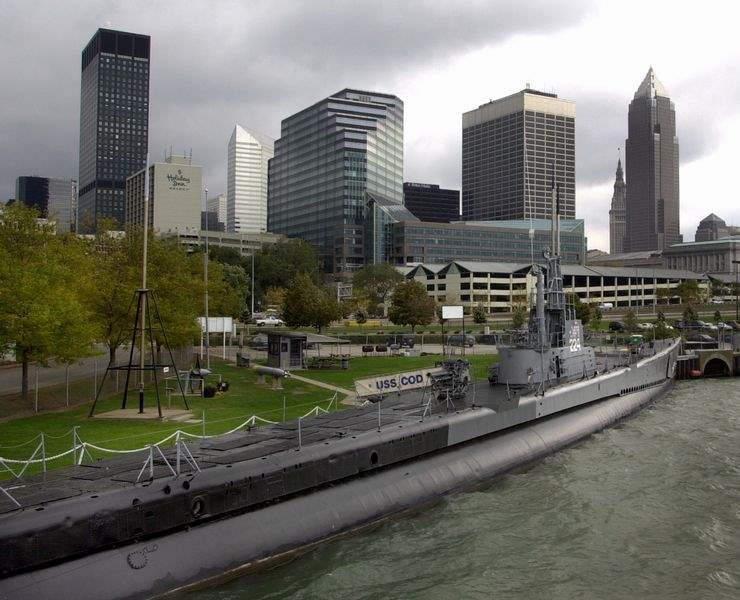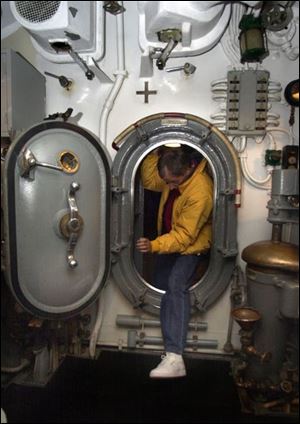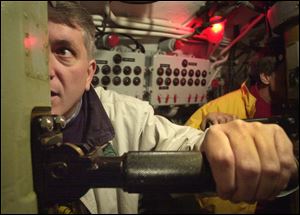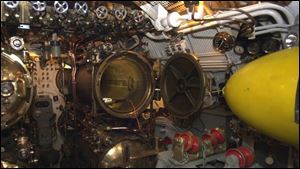
Toledo eyed for sub repair
10/27/2002
The USS Cod, moored in Cleveland, is one of only 15 remaining World War II fleet subs.
BLADE

The USS Cod, moored in Cleveland, is one of only 15 remaining World War II fleet subs.
CLEVELAND - If Dr. John Fakan, Paul Farace, and Toby Oothoudt have their way, a World War II submarine that is Ohio's only floating national historic landmark could be headed to Toledo for repairs in the next year or two.
The issue, as is often the case in such matters, is money.
The USS Cod, which in seven missions sunk at least 12 enemy ships, was assigned to Cleveland in 1959. Since 1976, it has been moored at a park in Cleveland's Lake Erie harbor, where 30,000 tourists a year have paid to visit what Mr. Farace, the Cod's curator, calls the most authentic of the country's 15 remaining World War II fleet subs.
The Cod not only has fascinated its visitors, it has lured others into a lifelong relationship.

Toby Oothoudt demonstrates what a tight fit the hatches are on the World War II submarine USS Cod.
Dr. Fakan, a retired NASA physicist who worked on the moon launches, first learned about the Cod when he helped install a radio antennae tower near the sub. Before he knew it, he became president about a decade ago of the Cleveland Coordinating Committee for Cod, Inc., and now is charged with raising the $1 million he figures it will take to refurbish the sub's hull.
“I am absolutely shameless when it comes to the Cod,” he says of his effort to keep the sub in good shape. “We're preserving a national treasure.”
Mr. Farace, a Cleveland native, saw the sub at age 8 when he tagged along with his father's summer-school class.
“I fell in love with it,” he says.
While a freshman at Cleveland State University, Mr. Farace was hired as a part-time tour guide. Now 44, his ultimate hobby is the Cod. If there is such a thing as a sub nerd, Mr. Farace is it.
Mr. Oothoudt, a Toledo freelance writer, became involved with the submarine several years ago when he met Mr. Farace during a tour of the Cod. Mr. Oothoudt's interest is personal: His father had perished on a similar sub, the USS Shark 2, in 1944 at age 20, three weeks before Mr. Oothoudt was born.
“The Cod is a tribute to the 3,500 men who went out [on subs] and didn't come back,” he says.

Curator Paul Farace has been fascinated by the USS Cod since he first visited it with his father at the age of 8.
The black and gray sub, measuring 310 feet long by only 16 feet wide inside, carries its history on its exterior. There is a Japanese flag for every enemy ship sunk and a martini glass. memorializing the Cod's rescue of 56 Dutch sailors from their grounded sub in 1945. It was the only international submarine-to-submarine rescue in history, Mr. Farace said.
In seven missions, the Cod lost only one sailor - Andrew Johnson, who was washed overboard while securing a hatch in 1945. Mr. Farace says the achievement is remarkable considering that 22 percent of the U.S. sub crews died in the war.
Sub crews made up only 2 percent of Allied forces in the Pacific theater but sank 55 percent of enemy ships lost in the Pacific theater, Mr. Farace said.
Around 1990, he and other Cod committee members began a serious effort to restore the submarine to its original form. They scoured the country looking for everything from Navy blankets to deck guns to radio parts.

The forward torpedo room of the USS Cod shows how narrow the interior of World War II-era submarines were, measuring in this instance only 16 feet across.
“It's weird stuff,” Mr. Farace says. “You find a VFW post that has a deck gun and you go there and horse trade with them.”
Their efforts are evident in a tour of the sub. It appears Cod sailors could return any minute. Canned rations remain on the floor, tucked into every nook and cranny. Photos of the crews and their families sit on desks and tables. The original radio works fine, as does everything from the sub's ice cream maker to the smallest fan and light.
“My theory is that everything should work, [though] it doesn't mean you use it,” Dr. Fakan says.
The Cod last was dry-docked for hull repairs in 1963 in Toledo. Normally, a salt-water boat will need to have its hull refurbished every five years. The fresh waters of Lake Erie, coupled with the care given the Cod by its committee members, have kept the sub in decent shape for four decades.
But, says Mr. Farace, “we've done everything we can do above the water.”
Dr. Fakan had hoped to get state assistance for the hull work, but with the struggling economy he now believes it will take a combination of government aid and a grass-roots campaign in which individuals contributing small amounts carry the day. He has visited a dry-dock site in Ontario, where the price would be more favorable, but would rather keep the work in the United States.
“Toledo is the closest and most convenient place,” he says, adding that the work will take about a month.
Jim Lynch assistant general manager of Toledo ShipRepair Co. says he would welcome the challenge of repairing the Cod.
“We have never done a submarine before,” he says.
His company did refurbish the SS John W. Brown, a World War II Liberty ship, two years ago and will begin work on a wooden schooner shortly.
If Toledo ShipRepair is selected, Mr. Lynch says his company would work with the Cod committee to give them the best deal possible out of respect for the submarine, its crew, and its caretakers.
“We would work with people like that,” he says.